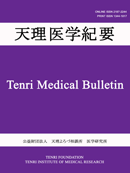Volume 26, Issue 1
Displaying 1-11 of 11 articles from this issue
- |<
- <
- 1
- >
- >|
Special Article
-
2023 Volume 26 Issue 1 Pages 1-13
Published: December 25, 2023
Released on J-STAGE: July 01, 2023
Download PDF (7554K) Full view HTML
Case Report
-
2023 Volume 26 Issue 1 Pages 14-19
Published: December 25, 2023
Released on J-STAGE: July 01, 2023
Download PDF (3313K) Full view HTML -
2023 Volume 26 Issue 1 Pages 20-31
Published: December 25, 2023
Released on J-STAGE: July 01, 2023
Download PDF (7538K) Full view HTML
Review Article
-
2023 Volume 26 Issue 1 Pages 32-53
Published: December 25, 2023
Released on J-STAGE: July 01, 2023
Download PDF (14746K) Full view HTML
Award (2022)
-
Article type: Award (2022)
2023 Volume 26 Issue 1 Pages 56-57
Published: December 25, 2023
Released on J-STAGE: July 01, 2023
Download PDF (1370K) -
Article type: Award (2022)
2023 Volume 26 Issue 1 Pages 58-59
Published: December 25, 2023
Released on J-STAGE: July 01, 2023
Download PDF (1776K) -
Article type: Award (2022)
2023 Volume 26 Issue 1 Pages 60-61
Published: December 25, 2023
Released on J-STAGE: July 01, 2023
Download PDF (1623K) -
Article type: Award (2022)
2023 Volume 26 Issue 1 Pages 62-64
Published: December 25, 2023
Released on J-STAGE: July 01, 2023
Download PDF (3463K)
Pictures at Bedside and Bench
-
2023 Volume 26 Issue 1 Pages 65-68
Published: December 25, 2023
Released on J-STAGE: July 01, 2023
Download PDF (2374K) Full view HTML -
2023 Volume 26 Issue 1 Pages 69-71
Published: December 25, 2023
Released on J-STAGE: July 01, 2023
Download PDF (1361K) Full view HTML -
2023 Volume 26 Issue 1 Pages 72-75
Published: December 25, 2023
Released on J-STAGE: July 01, 2023
Download PDF (3744K) Full view HTML
- |<
- <
- 1
- >
- >|
